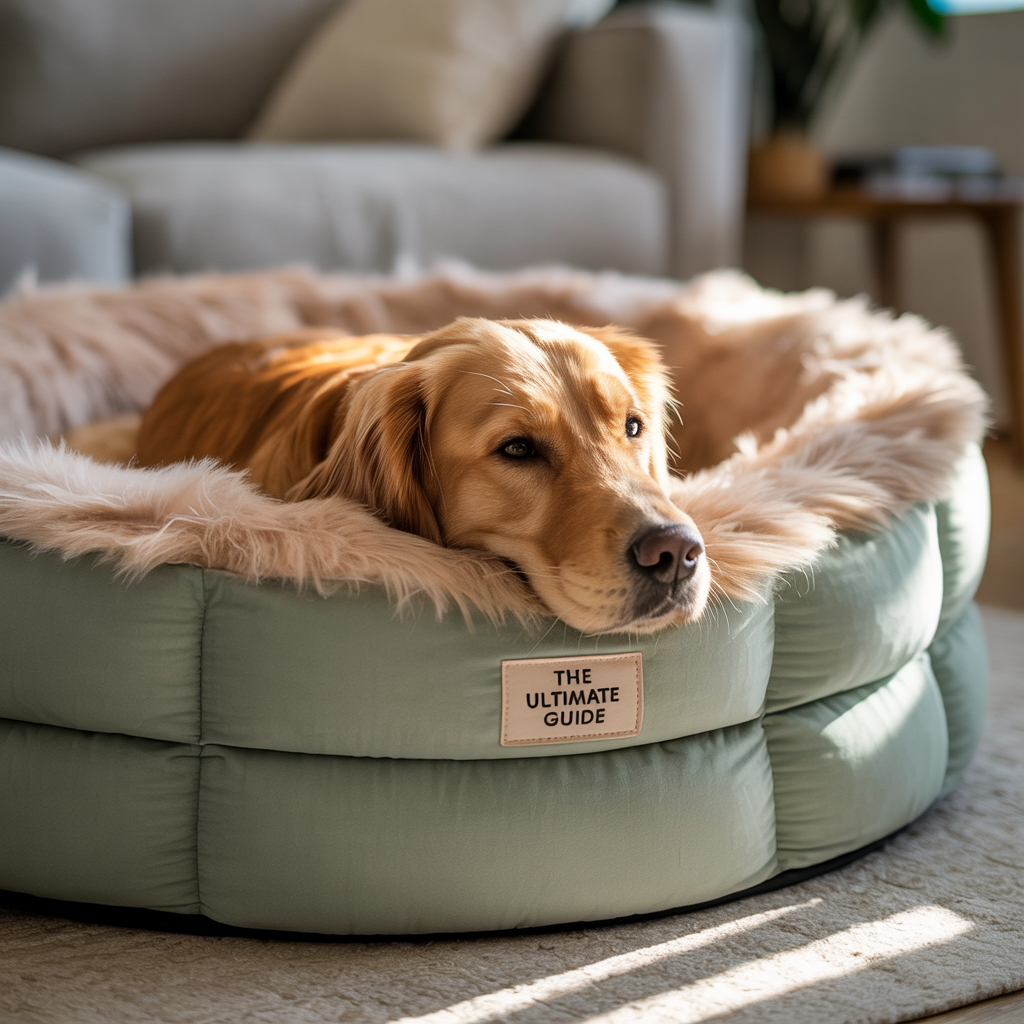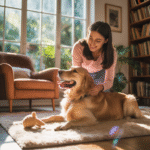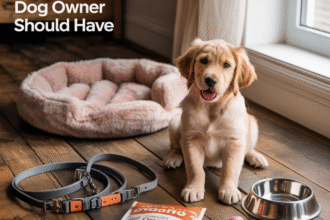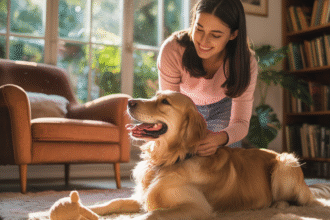A good night’s sleep isn’t just important for humans—your dog needs quality rest too. With dogs sleeping 12-14 hours per day on average, choosing the right bed is crucial for their health, comfort, and overall well-being. This comprehensive guide will help you navigate the world of dog beds to find the perfect match for your four-legged companion.
Why Your Dog Needs a Proper Bed
Before discussing selection criteria, it’s important to understand why investing in a quality dog bed matters. A proper bed provides joint support, regulates body temperature, creates a sense of security, and gives your dog its own designated space. Orthopedic support can make a significant difference in managing arthritis and hip dysplasia, especially for senior dogs.
Understanding Your Dog’s Sleeping Habits
Dogs have unique sleeping preferences that should influence your bed choice. Some dogs are “sprawlers” who like to stretch out completely, while others are “cuddlers” who prefer to curl up in a ball. “Burrowers” love to dig and nest under blankets, and “cool sleepers” tend to seek out cold surfaces like tile floors. Observing where and how your dog sleeps will provide valuable insights into their preferences.
Size Matters: Getting the Dimensions Right
The most common mistake dog owners make is buying a bed that’s too small. Your dog should be able to stretch out completely without hanging over the edges. To determine the right size, measure your dog from nose to tail and add 6-12 inches. For the width, measure from shoulder to shoulder and add the same buffer.
Size Guidelines:
- Small beds (up to 24″): Ideal for dogs under 25 pounds
- Medium beds (25-35″): Perfect for dogs 25-60 pounds
- Large beds (36-45″): Suitable for dogs 60-90 pounds
- Extra-large beds (46″+): Best for dogs over 90 pounds
Remember that puppies will grow, so consider their expected adult size when selecting.
Types of Dog Beds: Finding the Right Style
Standard Cushion Beds
These basic rectangular beds work well for most dogs and fit easily into crates or designated sleeping areas. They’re typically the most affordable option and come in various thicknesses.
Bolster and Raised-Edge Beds
It is perfect for dogs who like to rest their heads on something or feel secure with boundaries around them. The raised edges provide security and can help anxious dogs feel more comfortable.
Orthopedic and Memory Foam Beds
Essential for senior dogs, large breeds prone to joint issues, or any dog with existing mobility problems. These beds distribute weight evenly and reduce pressure points, promoting better sleep quality and joint health.
Elevated and Cooling Beds
These beds are ideal for dogs who overheat easily or live in warm climates. They promote air circulation and keep your dog cool during sleep. They’re also easier to clean and help prevent moisture buildup.
Cave and Donut Beds
These beds are perfect for small dogs, anxious pets, or those who love to burrow. They provide a cocoon-like environment that helps dogs feel secure and warm.
Outdoor and Waterproof Beds
Designed for dogs who spend time outside or for use in areas prone to accidents. These beds feature weather-resistant materials and are easy to hose down.
Material Considerations
Fill Materials
Memory foam offers superior support and comfort, especially for joint issues. Polyester fiberfill is budget-friendly and machine-washable, but may flatten over time. Cedar chips provide natural insect resistance and odor control. Gel-infused foam offers cooling properties for dogs who tend to overheat.
Cover Fabrics
Canvas is durable and easy to clean, but may be rough for sensitive skin. Fleece provides warmth and comfort but can attract hair and may not be ideal for heavy shedders. Microfiber resists stains and is soft to the touch. Waterproof materials are essential for puppies or older dogs prone to accidents.
Special Considerations for Different Life Stages
Puppies
Young dogs need beds that can withstand chewing and accidents. Look for waterproof options with removable, washable covers. Avoid expensive memory foam beds until your dog is fully house-trained and past the destructive chewing phase.
Adult Dogs
Focus on matching the bed type to your dog’s sleeping style and any specific needs like temperature regulation or anxiety management. This is when investing in higher-quality materials becomes worthwhile.
Senior Dogs
Orthopedic support becomes crucial as dogs age. Look for beds with memory foam, easy entry (low sides), and non-slip bottoms to prevent falls. Consider beds with extra cushioning for dogs with arthritis or hip dysplasia.
Health Considerations
Certain health conditions require specific bed features. Dogs with arthritis benefit from memory foam and easy access designs. Hip dysplasia sufferers need firm, supportive surfaces. Dogs with allergies require hypoallergenic materials and frequent washing capabilities. Overweight dogs need extra-supportive beds that won’t flatten under their weight.
Maintenance and Durability
Consider how easy the bed will be to maintain. Removable, machine-washable covers are essential for hygiene. Check the quality of zippers and stitching, as these are common failure points. Water-resistant or waterproof liners protect the internal filling from accidents and spills.
Look for beds with reinforced seams, especially if a dog likes to dig or scratch. Some manufacturers offer chew-resistant options for destructive dogs, though no bed is truly “chew-proof.”
Budget Considerations and Value
Dog beds range from under $20 to several hundred dollars. While expensive doesn’t always mean better, extremely cheap beds often lack durability and proper support. Consider the bed as a long-term investment in your dog’s health and comfort.
Mid-range beds ($50-150) often offer the best value, providing good materials and construction without premium pricing. For dogs with specific health needs, investing in a higher-end orthopedic bed can actually save money on veterinary bills in the long run.
Where to Place Your Dog’s Bed
Location significantly impacts your dog’s willingness to use their new bed. Most dogs prefer sleeping near their family, so consider placing the bed in your bedroom or a main living area. Ensure the location is away from high-traffic areas, allowing your dog to observe household activities.
The spot should be draft-free and not directly aligned with heating or cooling vents. If your dog has a favorite sleeping spot, try placing the new bed there first.
Making the Transition
Some dogs love their new beds immediately, while others need time to adjust. Make the bed more appealing by placing your dog’s favorite toy or a piece of your clothing on it. You can also encourage use by giving treats when your dog approaches or lies on the bed.
If your dog seems hesitant, don’t force them. Instead, make the bed as comfortable and appealing as possible, allowing them to discover it naturally.
Red Flags to Avoid
If your dog chews, steer clear of beds with poor-quality zippers that can break easily or pose choking hazards. Also, avoid beds with excessive padding that your dog’s nails can get caught in, and skip any bed with a strong chemical odor, which may indicate low-quality materials or harmful treatments.
Be wary of beds that are significantly cheaper than similar products. These beds often use inferior materials that won’t provide adequate support or durability.
Top Features to Look For
When shopping, prioritize removable and washable covers for easy maintenance. Non-slip bottoms prevent the bed from sliding around on smooth floors. Reinforced stitching and quality construction ensure longevity. Size options that match your dog’s current and future needs are essential.
Consider beds with trial periods or warranties, which indicate manufacturer confidence in product quality.
Final Recommendations
The perfect dog bed balances your dog’s individual needs, your budget, and your home’s requirements. Start by assessing your dog’s sleeping habits, health needs, and size requirements. Don’t be swayed by marketing claims alone—read reviews from other dog owners and consider your dog’s specific circumstances.
Remember that the most expensive bed isn’t always the best choice. Investing in quality materials and construction will provide better value over time. Your dog’s comfort and health are worth investing in a proper bed that will serve them well for years.
A well-chosen dog bed is more than just a sleeping surface—it’s a foundation for your dog’s health, comfort, and happiness. Take the time to choose wisely, and you and your furry friend will reap the benefits of better sleep and improved quality of life.





